
Hideously belated observing report: another Messier Marathon at the Salton Sea (from April 2019)
August 16, 2020Although you’d never know it from the complete dearth of posting from October, 2018, to last month, I neither died nor gave up stargazing. I even had some pretty cool experiences, I just didn’t summon the energy to blog about them. I’m now going to engage in some retrospective pothole-filling, starting with my 6th and most recent Messier Marathon.
Terry Nakazono had gotten in touch and we decided to make a run to the Salton Sea on the evening of Saturday, April 6, 2019. After logging over 2000 deep-sky objects with telescopes of 4.5″ and smaller, Terry had finally allowed himself to indulge and had moved up to his 5″ f/8 Meade reflector, which he had mounted on an AZ4 alt-az.
I was feeling lazy and didn’t want to dig a bunch of gear out of the back of the garage, so I brought London’s XT4.5, which is just an astoundingly comfortable and convenient scope. It normally sits near the front of the garage and these days it probably gets hauled out more than all the other scopes we own combined, just because it’s so quick and gives such good views. If London takes it with him when he moves away someday, I will definitely get one for myself. You can see it here on the homemade stand I made for it a few years ago, to get it up to a comfortable height for seated observing.
I wanted to do a Messier Marathon, but April 6 is getting right to the end of the season, so I figured I’d have some trouble with the early evening objects like M74 and M77. In the actual event, it was way worse: between the light pollution from LA, Palm Springs, and Indio, some clouds in the northwestern sky, and some trees in that direction, I missed not only M74 and M77 but also the Andromeda galaxy (M31) and its satellites M32 and M110, as well as M33. So I started the marathon six objects down out of 110, and the best I’d be able to do if everything else went smoothly was 104 Messiers. Still, I figured what the heck, I’d done my first three marathons (linked here) without getting that many, and there was no shame in ending over 100, especially if I had an enjoyable night under the stars doing it. So I went for it.
How’d it go? Other than losing those six galaxies at the start, it was my easiest marathon ever. I had the Jumbo Pocket Sky Atlas and the Year-Round Messier Marathon Field Guide, a handwritten checklist (like my other last-minute Marathon, back in 2013), my favorite 7×50 binos, and a super-convenient scope. I only used 3 eyepieces: a 32mm Plossl for max FOV, a 28mm RKE, and a 12mm Plossl, which in the XT4.5 yielded 28x, 32x, and 75x, respectively. Once I was rolling, I used the 28mm RKE almost exclusively. The reputation of this legendary eyepiece is well-earned; for the kind of relaxed, low-power deep-sky work I prefer it is unparalleled. All the gear just sort of disappeared and I was cruising through the sky, having fun and enjoying a beautiful night out under the stars.
A highlight of the evening was rocking through the Virgo-Coma galaxies. Ever since my first marathon, way back in 2010, I have always tracked how long it takes me to get through this area. That first time out it took an hour and a half, but I hadn’t logged many Messiers at that point so it was my first time seeing most of them. The next year it only took me 23 minutes, and since then it’s never taken me more than 17 or 18 minutes. My record is 16 minutes, set in 2011 with binos only, and I tied that this time out with the scope.
I knocked off at 11:30 with 64 objects logged, and slept until 3:00–easily my longest and most relaxing mid-Marathon break. I was back at the scope at 3:10 to log M57, and from then on it was smooth sailing through the morning objects. I set a new record for myself in the Sagittarius/Scutum area, logging 13 objects in 6 minutes. And honestly, a good chunk of that time was just writing them down. Once you know the positions of the objects, you can basically just sweep the scope or binos across the area and count them off as you go.
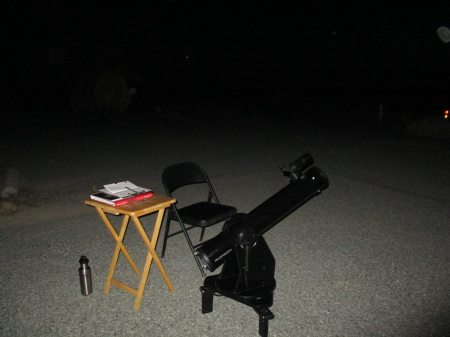
How I roll in the middle of the night: atlases and logbook on a folding table, water bottle on the ground where it’s not taking up valuable real estate. Photo by Terry Nakazono.
For the last few objects, I was basically waiting for them to crawl over the eastern horizon. Here are the times for the final five:
- M72, 4:14 AM
- M73, 4:15
- M2, 4:17
- M15, 4:20
- M30, 4:50
Yes, I got M30, the squirrelly devil, and finished with a total of 104 objects, having bagged every single Messier beyond those six starting galaxies. In the long downtime between M15 and M30 I looked in on Jupiter and Saturn, and after the Marathon was over I plinked around in the summer constellations, checking out NGC objects until about 5:20, when the sky was getting bright. Then I hit the sack and slept for another four hours.
Thoughts afterward? More than any previous Marathon, this one was just fun. Maybe because I knew right out of the gate that I wasn’t going to break my previous Messier Marathon total (108 objects, in 2013 and 2016), I just relaxed and had a blast cruising around the sky. I’ve done enough Messier Marathons now that the process feels familiar, and it’s nice looking in on objects that (full confession) I don’t often check in on otherwise (looking at you, M73).

The secret to sleeping in late in the desert is to park the vehicle perpendicular to the rising sun and put your cots on the west side. That’s me sacked out closest to the truck, sleeping like a baby after a successful Marathon. Photo by Terry Nakazono.
Of course, I’m still hungry to log all 110 in one night. I think I might need even darker skies and better horizons than the Salton Sea, so I am seriously considering hauling myself eastward for the All-Arizona Messier Marathon. Maybe next spring, if this damned pandemic ever subsides.
Many thanks to Terry Nakazono for being a sterling observing buddy, and for taking many of these photos and giving me permission to post them. Until next time!
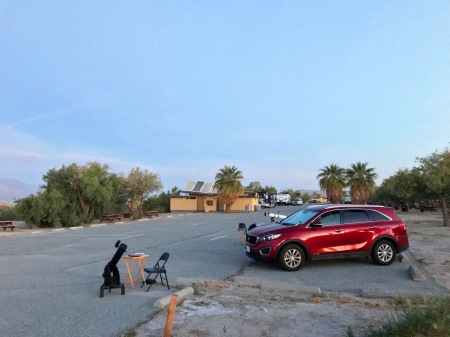
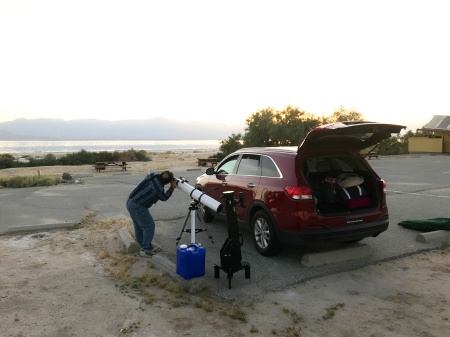
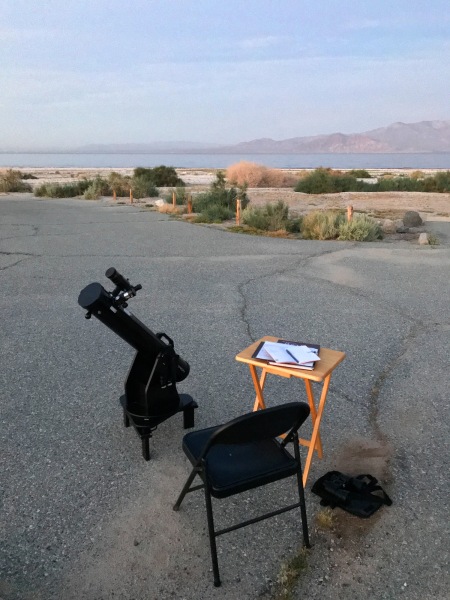
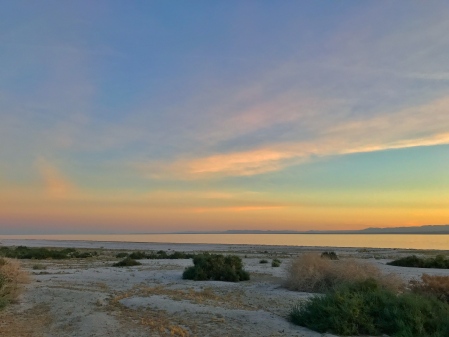
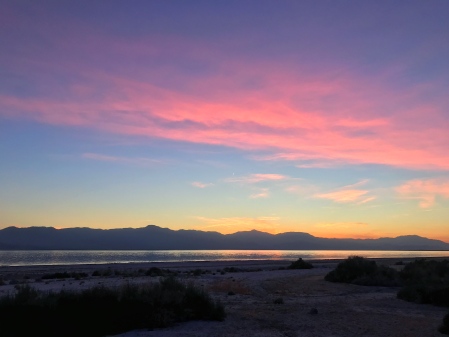
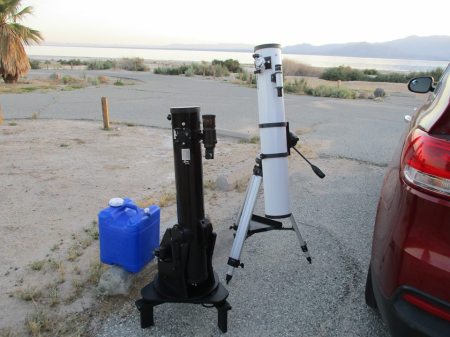
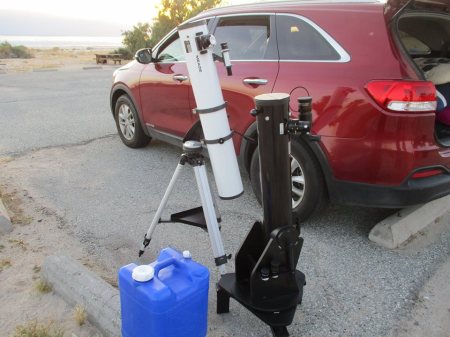
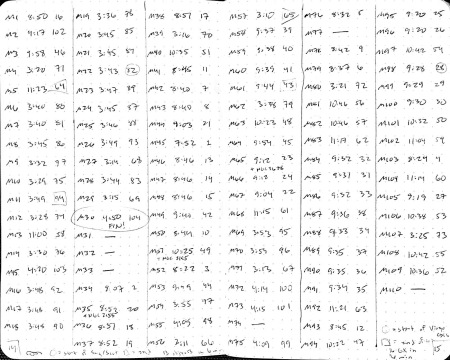
Thanks for posting Matt! The highlight of that session for me was seeing individual stars within the globular cluster Omega Centauri for the very first time. From Malibu, it was just a big oval shaped cotton ball.
I’ve now moved up to a Bresser 150mm F/8 Newt, observing from home.
Never thought to just use cots! Very nice report.
Thanks! Basically, I’m lazy, and if I can spare the time and effort it takes to set up and tear down a tent, I will. If it’s on the warm side, a cot beats a tent anyway, and if it’s on the cool side I just dress warm, zip up my mummy bag, and tough it.
Plus it’s nice to wake up in the middle of the night and chart the progress of the stars as they wheel overhead.
What was that big blue container used for storing moonshine or catching neutrinos!?
Ah, that’s my 7-gallon water jug. In my day job I go on dinosaur digs in the desert (for example), and it’s gotten me into the very healthy habit of taking extra water anytime I head out.
[…] I set up at 10:15 PM, started the Messier observations at 10:45, and continued in that mode for 5 hours, including breaks. During that time I logged an even 25 Messier objects. I got to the right field for five others–M76, M72, M110, M1, and M78–but couldn’t see them under the conditions I had. Along the way I also observed 3 meteors, the Moon, 3 planets, 7 double stars, and 14 non-Messier DSOs, for a total of 53 objects. It was my longest observing session since the Messier Marathon in April, 2019. […]